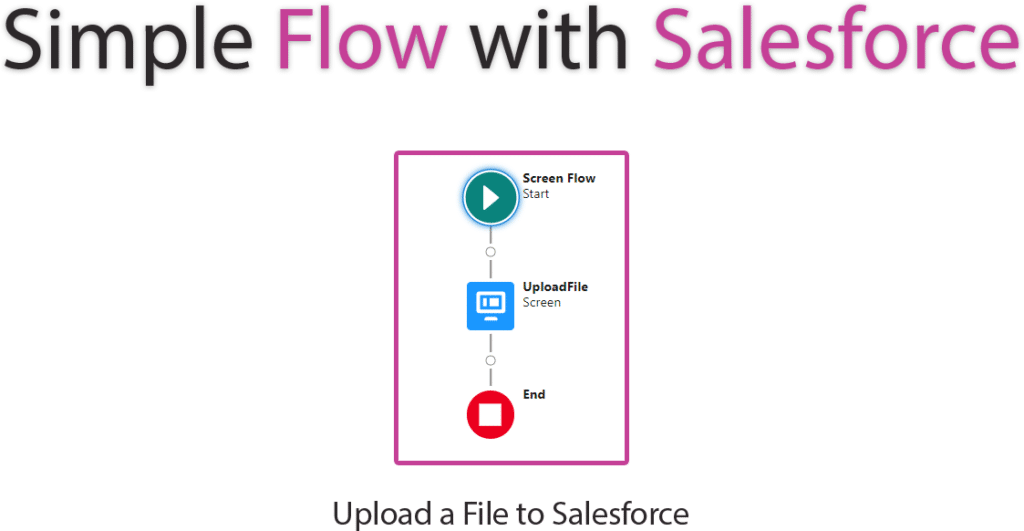Streamlining Salesforce Flow File Uploads for Better Performance
Creating custom processes that include Salesforce to upload files is easy with the Flow tool. Found directly in your CRM platform, Salesforce Flow is a powerful component for building automated workflows with no code.
Join us in the article below as we explore Salesforce Flow. We really want to show you how to maximize Salesforce automation tools that speed up file uploads to Salesforce. But stick around until the end, as we also cover Salesforce Automation Processes with Titan Flow.
Let’s start with Salesforce Flow to upload a file.
Salesforce Flow for File Uploads
We don’t think anyone loves manual and repetitive tasks, such as file uploads in Salesforce. Actually, we are pretty sure that employees would rather spend their time focusing on higher-level creative tasks than uploading files and monitoring their progress for successful data transfers.
File uploads with Flow from Salesforce can automatically move your content to records and objects. Using Salesforce Flow for file uploads keeps your database well organized and makes finding business content super easy.
File Uploads with Salesforce Screen Flow
Salesforce provides premium solutions for uploading files. For example, you could build an app for file uploads with Screen Flow from Salesforce.
By using Salesforce Screen Flow, file uploads become a super interactive experience for employees. The result is that they will be guided through some screens with directions and functionality to upload files to Salesforce.
Create Screen Elements
If you want to create screens that guide Salesforce users through a process that includes file uploads, we got you covered. You have two options to build screen elements in Salesforce:
In this short article, we will cover creating screen elements with Lighting Component Frameworks, but choose the one that works best for your workflows.
So, to create a screen element in Salesforce, go to Setup and search for Lightning Components in your Quick Find box. Once you access it, click on the New button, and you will be prompted to provide a name and description for the type of component you are about to create.
Now, you need to write some code like markup and controller logic to direct the Lightning component’s actions and appearance.
Once complete, you can drag and drop the component to a Lightning page with the App Builder.
Create Record Elements
Another important step to consider when automating file uploads in Salesforce is to create records. We cover this topic as many teams prefer storing files as records to keep their Salesforce platform neat and organized. After all, storing files with their specific accounts or contacts is a much easier way of working.
To create record elements in Salesforce with the user interface, go to the Object tab you want to work with and click the New button. Provide the details in the Salesforce form to create a new record and save your configuration. It’s that simple!
Attach a File Screen Element
Try the Attach File screen element if you need a clear button or link to let users upload files to Salesforce. When you add this button or link to your projects, people can upload files quickly from any device to Salesforce, which makes it a super convenient option for employees who are always on the go. The best part about this screen element is that it automatically attaches uploaded files to Salesforce records. Then, anyone accessing your Salesforce org can work with the most current documents and images.
Submitting Confirmation Screen Elements
Sometimes, you should add a Submit Confirmation screen element to your file upload processes. You will include it in your experience if you want to let people know that their recently uploaded files were a success or failure.
Activate and Save the Flow
Whether you use workflow automation software or Salesforce Flow to create a streamlined process, it’s essential that you remember to save your configuration. Here is a simple guide that you can use to activate and save a Salesforce Flow.
The first step is to create a new flow or edit one for your specific process. When you are done configuring your flow to include screen elements and actions, you need to activate it. Simply click the Activate button in Flow Builder.
If you are creating a new flow, you will need to select the version of the flow you want to activate. Alternatively, if you have chosen to update a flow and have clicked the Activate button, the dialog box will ask you to confirm that you want to use the latest version.
Once you have selected a version, your flow will become active and available to Salesforce users. By default, an activated flow is saved by Salesforce. Nonetheless, some solid advice is to click the Save button when modifying flows to ensure that all your configurations are recognized.

Manage Salesforce File Uploads Without Code
As we mentioned, using automation features from Salesforce to upload files requires some coding knowledge. Let us introduce you to Titan Files for no-code file management experiences.
With Titan Files, Salesforce files travel through faster processes, giving users more freedom to work on innovative and creative tasks.
Teams can escape manual processes with Titan Files to create, modify, and upload multiple files from within Salesforce without writing a single line of code!
We also integrate Salesforce with 3rd-party cloud storage solutions so that files can be transferred automatically and archived according to your company’s best practices.
Frequently Asked Questions
How do I upload a file to a screen flow in Salesforce?
You will need to use components to achieve the exact method of uploading a file. The File Upload and Create Record components are popular methods for uploading files in Salesforce.
How to make file upload mandatory in Flow Salesforce?
When creating your screen component in Salesforce, make sure to pay attention to the properties. You can use it to set your component’s Required attribute. If you want someone to upload a file before moving to the next step in a flow, you should set the Required attribute to true.
How to upload a document in Salesforce Files using REST API?
First, you need to get an access token to authenticate requests. You can use OAuth 2.0 authentication. Next, you can grab your file and check that it is ready to be uploaded to Salesforce Files. Now, you can create a POST request to Salesforce Files and send an HTTP request to Salesforce REST API file upload. Lastly, go to Salesforce and see if your file was uploaded.
Powerful Digital Experiences Without Leaving Salesforce
Thanks for reading our article on uploading files to Salesforce with Flow. We hope we have inspired you to make the most out of the automation tools found in your CRM platform.
If you are looking for no-code solutions to establish end-to-end business processes with Salesforce, check out Titan Files. Our app provides limitless automation for Salesforce Files that includes virus scans, file conversions, and optical character recognition technology, to name a few.
For more information on Titan Files and working directly in Salesforce, contact us on our social media channels below.
We hope to see you soon!

Disclaimer: The comparisons listed in this article are based on information provided by the companies online and online reviews from users. If you found a mistake, please contact us.




